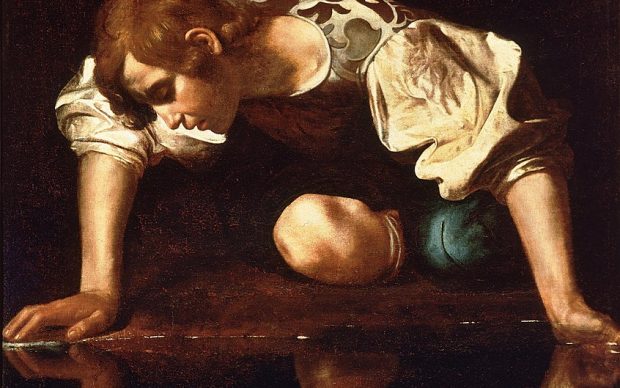Le strade del Barocco portano da Roma a Potsdam
15 Luglio 2019

In Germania, a pochi chilometri da Berlino è sorto nel 2017 uno spazio espositivo che porta un celebre nome italiano: il Museum Barberini di Potsdam onora con una nuova mostra il suo legame con l'Italia, in particolare con la collezione custodita dall'omonimo Palazzo Barberini a Roma.
A Postdam, la città tedesca confinante con la capitale Berlino, dallo scorso 2017 è visitabile un museo che porta un nome familiare, per gli italiani. Parliamo del Museum Barberini, che fino al prossimo 6 ottobre espone proprio una selezione di capolavori prestati dall’omonimo Palazzo Barberini e dalla Galleria Corsini a Roma.
Baroque Pathways: The National Galleries Barberini Corsini porta quindi in Germania 54 opere di epoca barocca, a cominciare dal Narciso di Caravaggio, dipinto tra il 1597 e il 1599 (in apertura, fonte Wikipedia). L’esposizione ripercorre appunto la diffusione su scala europea del rivoluzionario stile pittorico e compositivo introdotto da Michelangelo Merisi, oltre a esplorare il ruolo della famiglia Barberini come grandi mecenati e patroni dell’arte seicentesca.
Il Palazzo Barberini a Roma è in effetti il modello architettonico a cui si ispira l’edificio costruito a Potsdam, motivo per cui non è difficile comprendere il commento di Flaminia Gennari Santori, direttrice delle Gallerie Nazionali di Arte Antica capitoline, a proposito di questa inedita “trasferta” dei capolavori romani in Germania: “Siamo entusiasti di presentare parte della nostra collezione a Potsdam, una città che così tanti punti di contatto con l’arte e l’architettura di Roma“.
Oltre al già menzionato capolavoro caravaggesco, in Germania sono giunte opere di artisti appartenenti alla corrente caravaggesca e operanti sia a Roma – come Orazio Gentileschi e Giovanni Baglione – sia a Napoli, quali Luca Giordano e Battistello Caracciolo.
Il percorso espositivo si estende poi, in senso innanzitutto geografico, a toccare i caravaggisti del Nord Europa, principalmente provenienti dalle Fiandre e dalla Francia, che avevano potuto entrare in contatto con le opere del Merisi e della sua cerchia a Roma.
The Grand Tour, an educational journey which included an extensive sojourn in Italy and focused on antiquity, art and architecture, was an obligatory rite of passage for young European aristocrats. By the eighteenth century, private collections, like that of the Barberini, began to form an increasingly important part of the itinerary. For German princes, they became a model of their own collecting ambitions. They looked for classical subjects and had a penchant for allegories of the arts, epitomized in Rome by the work of Simon Vouet, Salvator Rosa, and Prospero Muti. The female figure holding a palette and paintbrush in Simon Vouet’s Allegory of Painting (Self-portrait) of the early 1620s is probably a portrait of Artemisia Gentileschi, the most famous female painter of the period. The exhibition presents two works by her from the collection of the Stiftung Preußische Schlösser und Gärten Berlin-Brandenburg (Prussian Palaces and Gardens Foundation Berlin Brandenburg).
Gallery of Foolishness: Italian Baroque Paintings in the New Palace in Potsdam
On loan from the Stiftung Preußische Schlösser und Gärten Berlin-Brandenburg, the two paintings, Lucretia and Sextus Tarquinius (ca. 1630) and David and Bathsheba (ca. 1635), leave the New Palace in Potsdam for the first time in 250 years to exemplify the influence of Roman baroque painting on German collections. When Frederick II (Frederick the Great), King of Prussia, acquired the paintings for the New Palace, he did not know that they had been painted by a woman. In 1769 he set up an Italian gallery with works by Giordano Bruni and Guido Reni as well as the two paintings now attributed to Artemisia Gentileschi. With its emphasis on biblical and mythological subjects, the gallery explored the disastrous consequences of male desire. The Prussian king, whose Sanssouci Palace, Ruinenberg and Barberini Palace drew on imperial as well as bucolic models, confronted his successor, Frederick William II, with this “Gallery of Foolishness.”
Palazzo Barberini: The Architectural Model for the Museum Barberini in Potsdam
The Museum Barberini was named after the Barberini Palace, built by Frederick the Great in central Potsdam. Destroyed in the Second World War, it was reconstructed as a modern museum on the original site by the Hasso Plattner Foundation between 2013 and 2016. The Prussian king, Frederick the Great, wanted an Italian piazza in Potsdam and found inspiration in an engraving of the Palazzo Barberini in Rome by Giambattista Piranesi. With this reference to Pope Urban VIII, a great patron of the arts, Frederick II laid claim to being an equally astute collector and connoisseur of art. Frederick and his successor, Frederick William II, commissioned numerous Italianate buildings in Potsdam.
Museum Barberini as a Starting Point for an Exploration of Italy in Potsdam
Complementing the exhibition Baroque Pathways, the Museum Barberini invites visitors to explore the Italian influence on Potsdam’s cityscape. The audio tour Italy in Potsdam on the Barberini App directs visitors to 30 Italianate buildings and works of art of the eighteenth and nineteenth century. Available in three languages (German, English and Italian), the self-guided city tour draws intriguing visual comparisons between Potsdam and Italy.
Italy in Potsdam
To mark the exhibition Baroque Pathways, the Stiftung Preußische Schlösser und Gärten Berlin-Brandenburg, the city of Potsdam and the Museum Barberini are turning the summer of 2019 into a citywide celebration of Italian art and culture. Guided tours, concerts, talks, film screenings, an open night at the Potsdam palaces, and many other events show Potsdam at it most Italianate. For more information on Italy in Potsdam, see (German only) https://www.potsdamtourismus.de/italien-in-potsdam/

